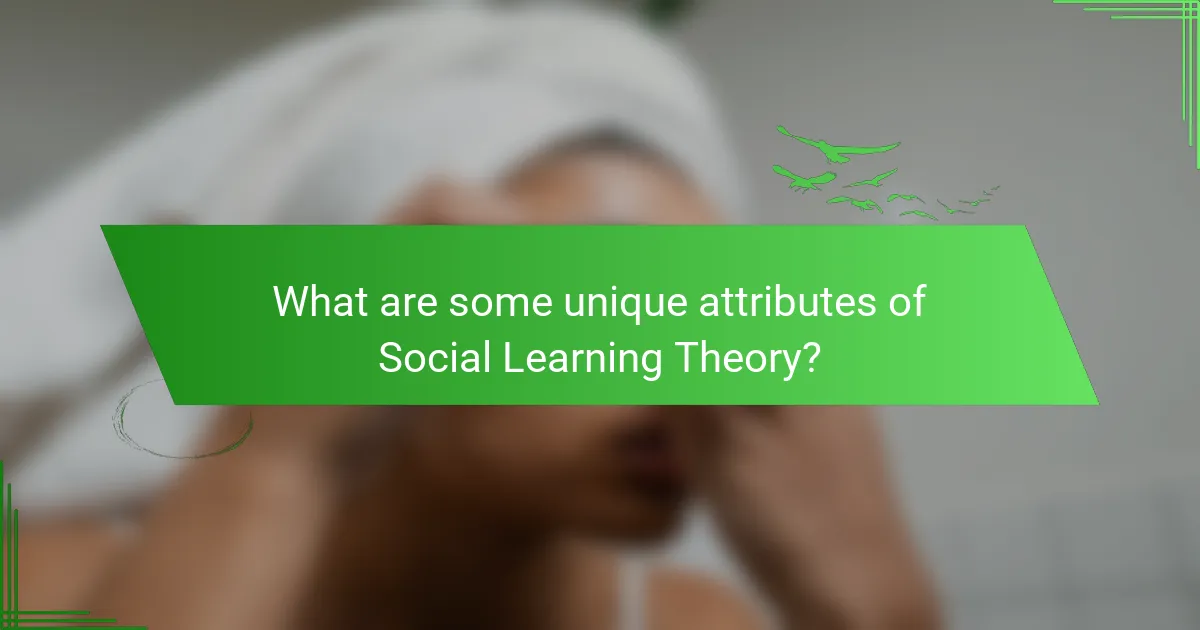Social Learning Theory offers valuable insights into how individuals learn through observation and imitation. This article explores its key components, including attention, retention, reproduction, and motivation. It also examines practical applications in educational settings, workplace dynamics, and behaviour modification. Understanding these aspects can enhance learning experiences and foster effective social interactions.

What is Social Learning Theory?
Social Learning Theory emphasizes learning through observation and imitation. It identifies key components such as attention, retention, reproduction, and motivation. Practical applications include educational settings, behaviour modification, and social interactions, demonstrating its relevance across various fields.
How does Social Learning Theory differ from traditional learning theories?
Social Learning Theory emphasizes learning through observation and interaction, unlike traditional theories that focus on direct experience. It incorporates social contexts and modelling behaviours as key components. Traditional theories often neglect these social factors, leading to a more individualistic approach to learning. Social Learning Theory also highlights the role of reinforcement and motivation derived from social interactions, which are less emphasized in traditional frameworks. This holistic perspective enhances understanding of how individuals learn in real-world environments.
What are the foundational principles of Social Learning Theory?
Social Learning Theory is based on the principles of observation, imitation, and modelling. Key components include attention, retention, reproduction, and motivation. These principles suggest that learning occurs in a social context and can happen through observing others, rather than through direct experience.
What role do observation and imitation play in Social Learning Theory?
Observation and imitation are crucial in Social Learning Theory, serving as primary mechanisms for acquiring new behaviours. Through observation, individuals learn by watching others, while imitation allows them to replicate those behaviours. This process emphasizes the importance of role models in shaping actions and attitudes. It highlights that learning occurs not just through direct experience but also through social interactions and environmental influences.
How does reinforcement influence learning in this context?
Reinforcement significantly enhances learning by providing feedback that encourages desired behaviours. In social learning theory, positive reinforcement, such as praise or rewards, increases the likelihood of repeating observed behaviours. This creates a cycle where individuals learn from both direct experiences and the experiences of others, effectively reinforcing social behaviours.

What are the key components of Social Learning Theory?
The key components of Social Learning Theory include attention, retention, reproduction, and motivation. Attention involves observing behaviours, retention is about remembering them, reproduction refers to the ability to replicate those behaviours, and motivation drives the desire to perform them based on observed outcomes. These components highlight how individuals learn through social interactions and modelling.
What is the significance of modelling in Social Learning Theory?
Modelling is crucial in Social Learning Theory as it demonstrates how individuals learn behaviours through observation. This process involves attention, retention, reproduction, and motivation, which are key components of learning. Observing role models allows individuals to acquire new skills and attitudes without direct experience. For instance, children often mimic behaviours seen in adults, highlighting the significance of modelling in shaping social norms and personal development.
How does attention affect learning outcomes?
Attention significantly enhances learning outcomes by improving focus and retention. When learners are engaged, they absorb information more effectively, leading to better comprehension and application of knowledge. Attention helps prioritize relevant information, filtering out distractions, which is crucial in social learning environments. For instance, active participation in group discussions fosters deeper understanding, as learners are more likely to retain insights shared by peers. Additionally, attention influences motivation; learners who are attentive tend to be more enthusiastic about the material, further driving positive learning outcomes.
What is the importance of retention in the learning process?
Retention is crucial in the learning process as it enhances knowledge acquisition and application. Effective retention allows learners to recall information, fostering deeper understanding and skill development. Social Learning Theory emphasizes the role of observation and modelling, which can significantly improve retention through shared experiences and collaborative learning. Engaging with peers and practicing learned concepts reinforces memory, making retention a key component of effective learning.
How does reproduction contribute to Social Learning Theory?
Reproduction enhances Social Learning Theory by facilitating the transmission of knowledge and behaviours across generations. Through observation and imitation, individuals learn from the experiences of others, which reinforces social norms and cultural practices. This process allows for the sharing of successful reproductive strategies, ultimately influencing social dynamics and individual development.
What are the motivational factors that influence learning?
Motivational factors influencing learning include intrinsic motivation, extrinsic rewards, social interaction, and self-efficacy. Intrinsic motivation drives engagement through personal interest, while extrinsic rewards, such as grades or praise, provide external incentives. Social interaction fosters collaborative learning, enhancing understanding through shared experiences. Self-efficacy, or belief in one’s capabilities, significantly impacts a learner’s persistence and effort. Each factor contributes uniquely, shaping the overall learning experience.

What are some unique attributes of Social Learning Theory?
Social Learning Theory emphasizes observation, imitation, and modelling as unique attributes. It highlights the significance of social context in learning processes. This theory uniquely integrates cognitive, behavioural, and environmental factors, showcasing how individuals learn from their surroundings. Additionally, it recognizes the role of self-efficacy in motivating behaviour change, a rare attribute that differentiates it from other learning theories.
How does Social Learning Theory apply to different cultures?
Social Learning Theory applies to different cultures by emphasizing observational learning within diverse social contexts. It highlights how cultural norms and values shape behaviours through modelling. For example, children in collectivist cultures may learn cooperation and group harmony, while those in individualist cultures may focus on personal achievement. This adaptability allows the theory to remain relevant across various cultural settings, reflecting unique attributes of each society’s learning processes.
What are the implications of Social Learning Theory for digital learning environments?
Social Learning Theory emphasizes the importance of social interaction in digital learning environments. It suggests that learners acquire knowledge through observation, imitation, and modelling behaviours from others.
Key implications include fostering collaborative learning spaces, encouraging peer feedback, and utilizing multimedia resources to enhance engagement. These elements promote active participation and reinforce the learning process.
Additionally, integrating social platforms allows learners to share experiences and insights, creating a community that supports knowledge retention. As a result, digital learning environments can become more dynamic and effective, aligning with the principles of Social Learning Theory.

What are the rare attributes of Social Learning Theory?
Social Learning Theory has rare attributes that distinguish it from other learning theories. These include the emphasis on observational learning, the role of self-efficacy in motivation, and the influence of social context on behaviour. Additionally, it highlights the importance of vicarious reinforcement, where individuals learn by observing the consequences of others’ actions.
How does Social Learning Theory address social change?
Social Learning Theory addresses social change by emphasizing the role of observation and imitation in learning behaviours. It posits that individuals learn from the experiences of others, which can lead to shifts in societal norms and values. For example, when influential figures model positive behaviours, such as environmental conservation, it encourages others to adopt similar practices. This collective change can result in significant social transformations, as behaviours spread through communities. The theory highlights the importance of social context in shaping individual actions, ultimately fostering a more adaptive society.
What role does empathy play in Social Learning Theory?
Empathy is crucial in Social Learning Theory as it enhances observational learning. By understanding others’ emotions and perspectives, individuals can better imitate behaviours and internalize social norms. This emotional connection fosters a supportive learning environment, encouraging collaboration and deeper comprehension of social cues. Empathy also facilitates the modelling of prosocial behaviours, reinforcing positive interactions within social contexts.

How can Social Learning Theory be applied in educational settings?
Social Learning Theory can enhance educational settings by promoting observational learning, modelling, and social interaction. Teachers can apply this theory by demonstrating behaviours, facilitating peer learning, and creating collaborative environments. Effective use of role models and real-life examples can improve student engagement and retention. Additionally, integrating technology can provide diverse platforms for social learning experiences.
What strategies can educators use to implement Social Learning Theory?
Educators can implement Social Learning Theory by fostering collaborative learning environments, utilizing modelling techniques, and encouraging peer interactions. These strategies enhance engagement and facilitate knowledge sharing among students.
1. Create group activities that promote teamwork and communication.
2. Use role-playing scenarios to demonstrate concepts and behaviours.
3. Incorporate technology, such as discussion forums, to facilitate peer learning.
4. Encourage reflective practices where students analyze their learning experiences.
How can peer learning enhance the application of Social Learning Theory?
Peer learning significantly enhances the application of Social Learning Theory by fostering collaboration and shared experiences. This approach allows individuals to learn from one another, reinforcing key components of the theory such as observational learning and modelling. As learners engage with peers, they develop social skills and gain diverse perspectives, which enrich their understanding and retention of information. Additionally, peer learning creates a supportive environment that encourages risk-taking and experimentation, essential for applying theoretical concepts in practical scenarios.

What are the practical applications of Social Learning Theory in the workplace?
Social Learning Theory can enhance workplace dynamics through mentorship, collaborative learning, and modelling behaviours. These applications foster a culture of shared knowledge and skills.
Mentorship programs leverage experienced employees to guide newcomers, reinforcing positive behaviours and skills. Collaborative learning encourages teamwork, allowing employees to learn from each other in real-time. Modelling behaviours promotes an environment where employees emulate the best practices demonstrated by peers and leaders.
These strategies lead to increased engagement, improved performance, and a stronger organizational culture.
How can organizations utilize Social Learning Theory for employee training?
Organizations can effectively utilize Social Learning Theory for employee training by fostering collaborative environments. This approach encourages learning through observation, imitation, and interaction among employees.
Key strategies include implementing mentorship programs where experienced employees model desired behaviours. Additionally, organizations can create opportunities for peer-to-peer learning through group projects and discussions that enhance knowledge sharing.
Incorporating technology, such as social media platforms or collaborative tools, can further facilitate informal learning and engagement. By recognizing the role of social context in learning, organizations can tailor training programs that resonate with employees and improve retention.
Ultimately, leveraging Social Learning Theory can lead to a more dynamic and adaptable workforce, enhancing overall organizational performance.
What are the benefits of using Social Learning Theory in team dynamics?
Using Social Learning Theory in team dynamics fosters collaboration, enhances communication, and promotes knowledge sharing. It encourages learning through observation, allowing team members to model behaviours and strategies from one another. This shared learning experience strengthens relationships and builds trust within the team. Additionally, it can lead to improved problem-solving skills as diverse perspectives are integrated. By leveraging the insights gained from peers, teams can adapt more effectively to challenges, resulting in higher overall performance.

What common mistakes should be avoided when applying Social Learning Theory?
To effectively apply Social Learning Theory, avoid common mistakes such as neglecting the role of observational learning, underestimating the impact of social context, failing to encourage active participation, and overlooking the importance of reinforcement. Each of these mistakes can hinder the effectiveness of learning experiences. Observational learning is crucial; learners must see role models in action. Social context influences motivation and engagement; consider the environment in which learning occurs. Active participation enhances retention and understanding; ensure learners are involved. Reinforcement strengthens behaviours; provide appropriate feedback to encourage desired outcomes.
How can practitioners ensure effective modelling in learning environments?
Practitioners can ensure effective modelling in learning environments by actively engaging learners through collaboration and observation. Utilizing group discussions and peer feedback fosters a supportive atmosphere. Incorporating real-world scenarios enhances relevance, while adapting teaching methods to individual learning styles promotes inclusivity. Regular assessment and reflection help refine practices, ensuring continuous improvement in modelling approaches.
What are some best practices for leveraging Social Learning Theory?
To effectively leverage Social Learning Theory, focus on modelling behaviours, providing opportunities for observation, and encouraging collaborative learning. Incorporate real-life examples to enhance understanding. Facilitate discussions that allow learners to share experiences and insights. Utilize technology to create interactive environments that promote engagement and knowledge sharing.
What tips can enhance the effectiveness of learning through observation?
To enhance the effectiveness of learning through observation, focus on active engagement and reflection. First, identify a knowledgeable model to observe. Next, take notes on key behaviours and strategies used by the model. After observation, reflect on what was learned and how it can be applied. Finally, practice the observed behaviours in real-life situations to reinforce learning.




